Related Research Articles
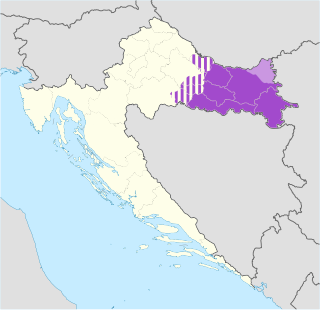
Slavonia is, with Dalmatia, Croatia proper and Istria, one of the four historical regions of Croatia. Taking up the east of the country, it roughly corresponds with five Croatian counties: Brod-Posavina, Osijek-Baranja, Požega-Slavonia, Virovitica-Podravina and Vukovar-Syrmia, although the territory of the counties includes Baranya, and the definition of the western extent of Slavonia as a region varies. The counties cover 12,556 square kilometres or 22.2% of Croatia, inhabited by 806,192—18.8% of Croatia's population. The largest city in the region is Osijek, followed by Slavonski Brod and Vinkovci.

Vinkovci is a city in Slavonia, in the Vukovar-Syrmia County in eastern Croatia. In the 2011 census, the total population of the city was 35,312, making it the largest town of the county. Surrounded by many large villages, it is a local transport hub, particularly because of its railways.

Vukovar-Syrmia County, Vukovar-Sirmium County or Vukovar-Srijem County is the easternmost Croatian county. It includes the eastern parts of the region of Slavonia and the western parts of the region of Syrmia, as well as the lower Sava river basin, Posavina and Danube river basin Podunavlje. Due to the overlapping definitions of geographic regions, division on Slavonia and Syrmia approximately divides the county vertically into north-east and south-west half, while division on Posavina and Podunavlje divides it horizontally on north-east and south-west half.

Brod-Posavina County is the southern Slavonian county in Croatia. Its center is the city of Slavonski Brod and it spreads along the left bank of the Sava river, hence the name Posavina. Other notable towns include Nova Gradiška.
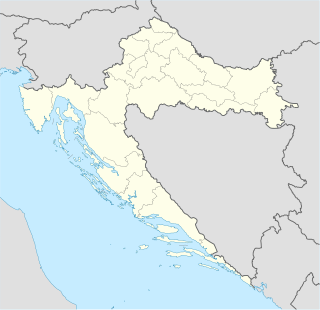
Operation Hurricane-91 was a military offensive undertaken by the Croatian Army against the Yugoslav People's Army and SAO Western Slavonia Territorial Defense Forces in the Sava River valley, in the region of Western Slavonia during the Croatian War of Independence. The operation began on 29 October 1991 and ended on 3 January 1992 when a nationwide ceasefire was signed to implement the Vance plan. The offensive was aimed at recapturing the region, in conjunction with two other HV offensives launched against SAO Western Slavonia in the north of the region within days.

The Lovas killings involved the killing of 70 Croat civilian residents of the village of Lovas between 10–18 October 1991, during the Croatian War of Independence. The killings took place during and in the immediate aftermath of the occupation of the village by the Yugoslav People's Army supported by Croatian Serb forces and Dušan Silni paramilitaries on 10 October, two days after Croatia declared independence from Yugoslavia. The occupation occurred during the Battle of Vukovar, as the JNA sought to consolidate its control over the area surrounding the city of Vukovar. The killings and abuse of the civilian population continued until 18 October, when troops guarding a group of civilians forced them to walk into a minefield at gunpoint and then opened fire upon them.
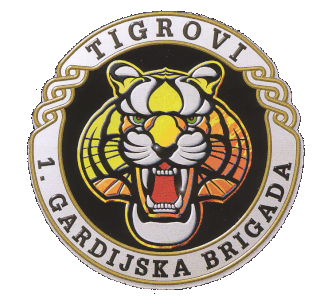
Croatia's First Mechanized Guard Brigade - named "The Tigers" - was the most elite and best equipped military brigade of the Croatian Army. Its military base and headquarters was in the Croatian capital of Zagreb, origin of most of the brigade's personnel. In 2008, as part of a larger military restructuring, the brigade-sized unit was disbanded and reformed as a battalion of the Motorized Guard Brigade.

The Battle of the Barracks was a series of engagements that occurred in mid-to-late 1991 between the Croatian National Guard and the Croatian police on one side and the Yugoslav People's Army on another. The battle took place around numerous JNA posts in Croatia, starting when Croatian forces blockaded the JNA barracks, weapons storage depots and other facilities. It formally began on 14 September; its objective was to neutralise the JNA positions in ZNG-held territory and to secure arms and ammunition supplies for the poorly equipped ZNG.
In Croatia, there are over 2,900 people who consider themselves German, most of these Danube Swabians. Germans are officially recognized as an autochthonous national minority, and as such, they elect a special representative to the Croatian Parliament, shared with members of eleven other national minorities. They are mainly concentrated in the area around Osijek in eastern Slavonia.
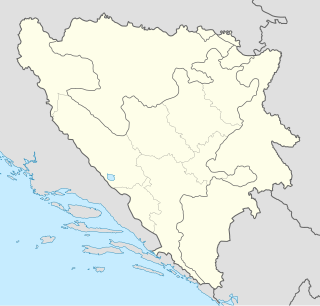
Operation Corridor 92 was the largest operation conducted during the Bosnian War by the Army of Republika Srpska (VRS) against the forces of the Croatian Defence Council (HVO) and the Croatian Army (HV) in the Bosanska Posavina region of northern Bosnia and Herzegovina between 24 June and 6 October 1992. The objective of the offensive was to re-establish a road link between the city of Banja Luka in the west of the country and the eastern parts of the territory controlled by the Bosnian Serbs. The offensive was prompted by the capture of Derventa by the HV and the HVO – a move that blocked the single overland road between the VRS-controlled territories.
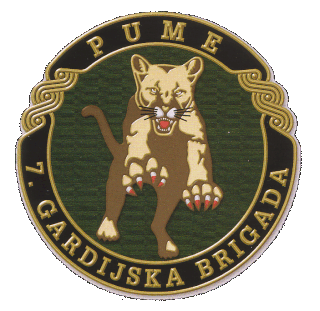
The 7th Guards Brigade, also known by their nickname Pumas, was a Croatian Ground Army (HV) brigade formed on 23 December 1992 in Varaždin. The brigade was initially formed out of the 5th Battalion of the 1st "Tigers" Brigade and its first commander was Ivan Korade, who led the unit during the War of Independence (1991–95).
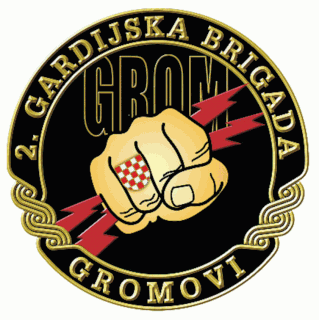
The 2nd Guards Brigade, also known by their nickname Thunders (Gromovi), was one of the original Croatian National Guard (ZNG) brigades formed in 1991 and one of the most elite mechanized infantry units in the Croatian Ground Army (HV) during its existence, during which it saw action in a number of engagements during the War of Independence (1991–1995).
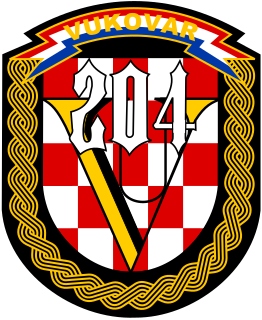
The 204th Vukovar Brigade of the Croatian Army was a military unit of the Republic of Croatia that led the defence of the city of Vukovar during the 1991 Battle of Vukovar, in the Croatian War of Independence.
The Battle of Osijek was the artillery bombardment of the Croatian city of Osijek by the Yugoslav People's Army (JNA) which took place from August 1991 to June 1992 during the Croatian War of Independence. Shelling peaked in late November and December 1991, then diminished in 1992 after the Vance plan was accepted by the combatants. Airstrikes and attacks by JNA infantry and armored units against targets in the city accompanied the bombardment, which caused approximately 800 deaths and resulted in a large portion of the city's population leaving. Croatian sources estimated that 6,000 artillery shells were fired against Osijek over the period.

Armored Mechanized Guard Brigade is a mechanized infantry brigade of the Croatian Army based in Vinkovci, Eastern Croatia. The GOMBR is the largest tactical unit of the Croatian Army and is commanded by Brigadier General Mijo Validžić.

The 1991 Yugoslav campaign in Croatia was a series of engagements between the Yugoslav People's Army (JNA), the Yugoslav Navy and the Yugoslav Air Force, and the Croatian National Guard (ZNG) then the Croatian Army (HV) during the Croatian War of Independence. The JNA was originally deployed in order to preserve Yugoslavia, and the initial plan of the campaign entailed the military occupation of Croatia and the removal of the Croatian leadership elected in 1990. The JNA intervention was the culmination of its involvement in the confiscation of weapons from Croatia's Territorial Defence, and in the Croatian Serb revolt that had begun in August 1990. From that time, the JNA had been frequently deployed to form a buffer zone between the insurgents and the ZNG or the Croatian police. In effect, these JNA buffer zones often secured the territorial gains of the insurgents and led to an increasingly hostile relationship between the JNA and Croatia. The JNA campaign plan was amended shortly before the campaign to include the relief of JNA barracks besieged by the ZNG. The besieging and subsequent capture of several JNA facilities allowed Croatia to arm its previously poorly equipped military and to equip new recruits.

The 2nd Army was a Royal Yugoslav Army formation commanded by Armijski đeneral Dragoslav Miljković that opposed the German-led Axis invasion of the Kingdom of Yugoslavia in April 1941 during World War II. It consisted of three infantry divisions and one horsed cavalry regiment along with supporting units. It formed part of the 2nd Army Group, and was responsible for the defence of the Yugoslav–Hungarian border along the Drava river from Slatina to the Danube.

Operation Baranja was an aborted offensive of the Croatian Army north of the towns of Belišće and Valpovo, Croatia on 3 April 1992 during the Croatian War of Independence. The offensive quickly gained ground after the HV advanced north of the Drava River into Baranja. The defending force of the Croatian Serb Territorial Defence Force supported by the Yugoslav People's Army artillery were caught unprepared and offered light resistance.

The Battle of Batina or Batina Operation is one of the battles of the Second World War which took place from 11 to 29 November 1944 at the village of Batina in Baranja, on the right bank of the Danube River, between the units of the Red Army and the People's Liberation Army against the Wehrmacht and their allies. According to some estimates, the Battle of Batina is the biggest battle by the number of participants, the intensity of fighting, and the strategic importance that occurred during the World War II in Yugoslavia.
Tank Battalion "Kune" is one to two armoured units within the Armoured Mechanized Guard Brigade (GOMBR) of the Croatian Army.
References
- ↑ "Povjesnica 3.gbr" [Background of the 3rd Guards Brigade] (in Croatian). Osijek, Croatia: Association of Veterans of the 3rd Guards Brigade. Retrieved 17 October 2011.[ permanent dead link ]
- ↑ Šebetovsky, Mario (July 2002). "The Battle of Vukovar: The Battle That Saved Croatia" (PDF). Quantico, VA: United States Marine Corps Command and Staff College, Marine Corps University. Retrieved 9 October 2011.
- ↑ Marijan, Davor (October 2002). "Bitka za Vukovar 1991" [The Battle of Vukovar, 1991](PDF). Scrinia Slavonica (in Croatian). Slavonski Brod: Croatian Historical Institute - Department of History of Slavonia, Srijem and Baranja. 2 (1): 367–402. ISSN 1332-4853 . Retrieved 6 October 2011.
- ↑ Hrvatske, MORH Ministarstvo obrane Republike (12 February 2018), 3. GARDIJSKA BRIGADA KUNE , retrieved 13 January 2020